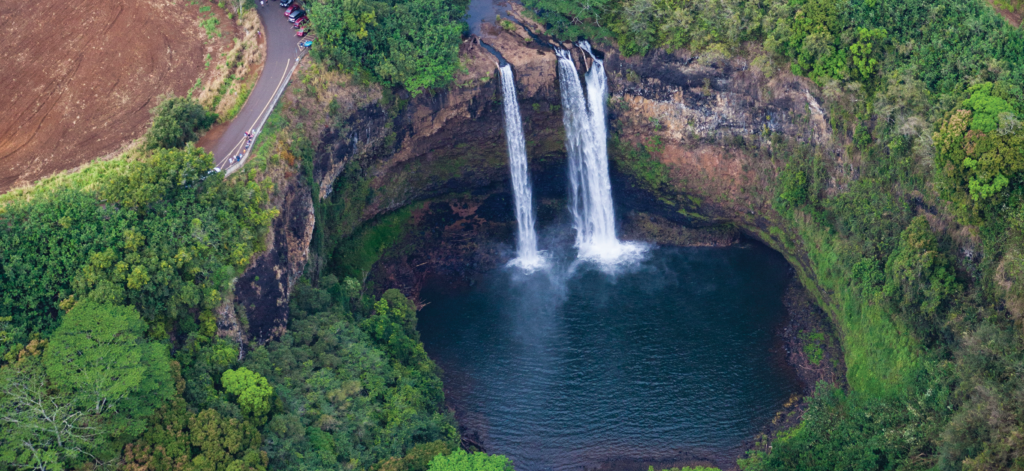Rallying Community and Academia in Support of Hawai‘i’s Water Sustainability
As an island state, Hawai‘i is dependent on its subsurface aquifers for its freshwater supply, recharged by rainwater that is naturally filtered through porous volcanic rock. Surprisingly, little is known about the relationship between various aquifers or the complex network of subsurface geological features that affect the flow of groundwater. However, due to an increasing population, changing land use practices and a range of issues relating to climate change—there is now an increased concern over water quality and quantity in the state.
Approximately 99 percent of Hawai‘i’s potable water supply is pumped from poorly understood subsurface aquifers, and a lack of regional data makes the future of this supply hard to predict. Stressors on the water supply are also emerging: 75 percent of the islands were abnormally dry in 2013; rainfall has decreased by 28 percent between 1973 and 2009; the population continues to increase at approximately one percent each year; and tourism reached an all-time high of over nine million visitors in 2016.
To help address this critical issue, the University of Hawai‘i (UH) was awarded $20 million by the National Science Foundation (NSF) to conduct a five-year, groundbreaking study on water sustainability in the islands. Through NSF’s Established Program to Support Competitive Research (EPSCoR), which is designed to attack major challenges that face individual states, UH’s winning proposal on water sustainability was placed in the forefront by a governing committee representing academia, the community and various federal, state and county agencies. Funded for 2016-2021, the project is now closing out its first successful year.
Named ‘Ike Wai—which in Hawaiian symbolizes knowledge (‘ike) of water (wai), the project establishes an unprecedented water research coalition in Hawai‘i, supplementing currently fragmented efforts with new technologies, cutting edge cyber-enabled knowledge gains and a new level of focus on accountability and stakeholder engagement. The partnership also includes the Hawai‘i State Departments of Health and Land and Natural Resources, Honolulu Board of Water Supply, Hawai‘i County Department of Water Supply, U.S. Geological Survey and other community partners.
“It was clear that this could not be a UH-stand alone effort. Water sustainability is such a complex problem that we needed to assemble a large team that includes community advocates, economists, federal agencies, and representatives from state and local government,” said Dr. Gwen Jacobs, ‘Ike Wai principal investigator and Director of Cyberinfrastructure for the UH System. “This project is unique in my experience at UH in that it combines cutting-edge science with community and stakeholder perspectives.”
‘Ike Wai is bringing a cadre of geologists, geophysicists, hydrologists, microbiologists, engineers, economic modelers and computational scientists together in a ‘Team Science’ framework.
The project leverages recent UH investments in high performance computing and the world’s best hybrid data visualization system, the Destiny-class CyberCANOE, developed by Dr. Jason Leigh of UH Mānoa’s Laboratory for Advance Visualization and Applications.
The multifaceted research program is focused on attaining a comprehensive understanding of subsurface water in Hawai‘i, its location, volume and flow paths as well as the current threats to sustainability from climate change, increasing population and development, contamination and fragile state infrastructure. The overall goals of the project belie its tremendous complexity.
“Simply put, the goal is decision support,” said team member Greg Chun, associate specialist at UH Mānoa’s Social Science Research Institute. “We will produce complex hydrological models of water location and flow that can inform decision making by a wide range of community, business and governmental stakeholders.”
Chun leads the ‘Ike Wai effort in community and stakeholder engagement, ensuring the fidelity of the project’s research to state needs, and brokering relationships with landowners to allow research to take place in critical yet poorly understood areas of Hawai‘i. As data emerges, he will lead a team that supplies the project’s findings to a range of audiences, with the goal of informing policy and decision-making in an unbiased fashion. The program also seeks to build capacity in the state for both water research and policymaking.
“We will be building capacity in a new degree certificate and degree program in data science and through new faculty hires in mathematics, natural sciences, computer sciences and social sciences,” said Dr. Matt Platz, vice chancellor for academic affairs at UH Hilo. “We will be initiating a new summer bridge program in math and data science focused on attracting promising high school students to pursue their undergraduate degree here.”
These transformative hires and program development at UH Hilo will be paralleled at UH Mānoa, where ‘Ike Wai will look to hire new faculty in engineering, social science and earth sciences and fund a comprehensive undergraduate program focused on research and professional development in Science, Technology, Engineering and Math (STEM) fields.
“Preparing the next generation is central to ‘Ike Wai—they are both the researchers and stakeholders of the future when it comes to water science in Hawai‘i,” said Dr. Barbara Bruno, education team leader. The program will also delve into the past, integrating Hawaiian traditional ecological and cultural knowledge into its research process. A team led by Dr. Puakea Nogelmeier of the Hawai‘inuiākea School of Hawaiian Knowledge is mining Hawaiian language newspapers and cultural sources such as mele (songs) to add the richness of the Hawaiian historical and cultural understanding of water dynamics to the EPSCoR project.
“‘Ike Wai science efforts for the first year are starting to coalesce and our relationships with agency partners are coming into focus,” said Jacobs. “Data collection using geochemistry, microbiology and custom-engineered well sensors is starting in earnest. By this time next year, we will be awash in data and we can’t wait to see the insights they deliver.”

